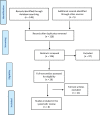Effect of oestrogen therapy on faecal incontinence in postmenopausal women: a systematic review
- PMID: 32130466
- PMCID: PMC7306041
- DOI: 10.1007/s00192-020-04252-1
Effect of oestrogen therapy on faecal incontinence in postmenopausal women: a systematic review
Abstract
Introduction and hypothesis: Faecal incontinence (FI) is prevalent in postmenopausal women. Oestrogen receptors have been identified in the anal sphincter and have been implicated in the pathogenesis and potential treatment. We sought to evaluate the literature regarding the impact of local and systemic oestrogen therapy on FI in postmenopausal women.
Methods: A systematic review of all studies in postmenopausal women was performed to establish how oestrogen therapy affects FI. Eight articles were deemed eligible for inclusion following the Preferred Reporting Items for Systematic Reviews and Meta-Analyses (PRISMA) guidelines. Their quality was assessed using the Cochrane risk-of-bias tool (RoB-2) and Newcastle-Ottawa quality assessment scale.
Results: One randomised controlled trial (RCT), two cohort studies, one observational and four cross-sectional studies were identified. The RCT showed an improvement in FI with anal oestrogen (p = 0.002), but this improvement was also observed in the placebo arm (p = 0.013) and no difference was seen between these groups. A prospective observational study demonstrated significant improvement with an oestrogen patch (p = 0.004), but had no control group. Conversely, a large prospective cohort study demonstrated an increased hazard ratio of FI with current (1.32; 95% CI, 1.20-1.45) and previous oestrogen use (1.26; 95% CI, 1.18-1.34) compared with non-users.
Conclusion: All studies had a high risk of bias and had conflicting views on the effects of oestrogen on FI in postmenopausal women. This review has identified the need for further research in this area by highlighting the paucity of good research for evidence-based practice. We believe that a further RCT of local oestrogen is mandated to draw a valid conclusion.
Keywords: Accidental bowel leakage; Faecal incontinence; Hormone replacement therapy; Oestrogen therapy; Postmenopausal; Systematic review.
Conflict of interest statement
None.
Figures
Similar articles
-
The influence of oestrogen replacement on faecal incontinence in postmenopausal women.Br J Obstet Gynaecol. 1997 Mar;104(3):311-5. doi: 10.1111/j.1471-0528.1997.tb11459.x. Br J Obstet Gynaecol. 1997. PMID: 9091007
-
Oestrogen therapy for treating pelvic organ prolapse in postmenopausal women.Cochrane Database Syst Rev. 2023 Jul 11;7(7):CD014592. doi: 10.1002/14651858.CD014592.pub2. Cochrane Database Syst Rev. 2023. PMID: 37431855 Free PMC article. Review.
-
Pelvic floor muscle training for preventing and treating urinary and faecal incontinence in antenatal and postnatal women.Cochrane Database Syst Rev. 2020 May 6;5(5):CD007471. doi: 10.1002/14651858.CD007471.pub4. Cochrane Database Syst Rev. 2020. PMID: 32378735 Free PMC article.
-
Menopausal Hormone Therapy Is Associated With Increased Risk of Fecal Incontinence in Women After Menopause.Gastroenterology. 2017 Jun;152(8):1915-1921.e1. doi: 10.1053/j.gastro.2017.02.005. Epub 2017 Feb 14. Gastroenterology. 2017. PMID: 28209529 Free PMC article.
-
Are topical oestrogens useful in faecal incontinence? Double-blind randomized trial.Colorectal Dis. 2009 May;11(4):390-3. doi: 10.1111/j.1463-1318.2008.01624.x. Epub 2008 Jul 11. Colorectal Dis. 2009. PMID: 18637100 Clinical Trial.
Cited by
-
Role of gut microbiota and fecal metabolites in the protective effect of soybean pulp-rich diet against estrogen-induced cholestasis in rats.Curr Res Food Sci. 2025 Jan 31;10:100990. doi: 10.1016/j.crfs.2025.100990. eCollection 2025. Curr Res Food Sci. 2025. PMID: 39995468 Free PMC article.
-
Paeoniflorin alleviates 17α-ethinylestradiol-induced cholestasis via the farnesoid X receptor-mediated bile acid homeostasis signaling pathway in rats.Front Pharmacol. 2022 Nov 21;13:1064653. doi: 10.3389/fphar.2022.1064653. eCollection 2022. Front Pharmacol. 2022. PMID: 36479204 Free PMC article.
-
Bidirectional Relationships between Sarcopenia and Pelvic Floor Disorders.Int J Environ Res Public Health. 2024 Jul 5;21(7):879. doi: 10.3390/ijerph21070879. Int J Environ Res Public Health. 2024. PMID: 39063456 Free PMC article. Review.
-
Non-ablative Erbium (YAG) and Neodymium (YAG) Laser Treatment for Anal Incontinence and Vaginal Atrophy: A Case Study.Cureus. 2024 Mar 5;16(3):e55542. doi: 10.7759/cureus.55542. eCollection 2024 Mar. Cureus. 2024. PMID: 38449912 Free PMC article.
-
Guideline for the diagnosis and treatment of Faecal Incontinence-A UEG/ESCP/ESNM/ESPCG collaboration.United European Gastroenterol J. 2022 Apr;10(3):251-286. doi: 10.1002/ueg2.12213. Epub 2022 Mar 18. United European Gastroenterol J. 2022. PMID: 35303758 Free PMC article.
References
Publication types
MeSH terms
Substances
LinkOut - more resources
Full Text Sources


